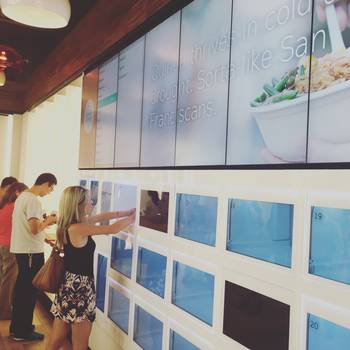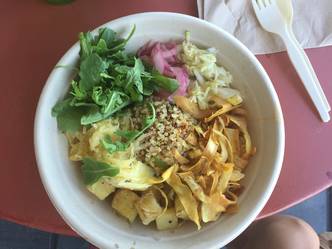Future Now
The IFTF Blog
Eatsa & The Future of Food Automation
IFTF's Food Lab is mapping Epicenters of Food Innovation. As part of that process, we seek out signals of change. A signal is a small or local innovation with the potential to disrupt the status quo. It can be a new product, practice, market strategy, policy, or technology. In short, signals are things that catch our attention and point to larger implications and bigger changes ahead. Signals are building blocks for imagining the future and clustering them together can inspire forecasts.
The Future of Food Automation?
We went to try the newly opened San Francisco restaurant, Eatsa, a modern take on the automat that serves quinoa bowls. The New York Times recently ran a story about it called "Restaurant of the Future: Service with an Impersonal Touch." A few months ago, our Technology Horizons program produced a map and held a conference on the Future of the Automated World where we explored how new automation technologies will impact everything from pharmaceutical R&D to children's toys and of course, the future of human work. So how will these emerging automation technologies change our food experiences over the next decade?
The short story: Eatsa was a fun and novel dining experience and a pretty large quantity of delicious, fresh food at a good price point ($6.95).


The line was at least 50 people deep when we arrived at 11:30am. It moved very quickly and we stepped up to one of the ipads to place our order. There were about 12 bowls on the menu as well as the option to fully customize your own. Once the order is placed, your name goes into a queue on the big display screen. Within a few minutes one of the boxes lights up with your name, and a fun animation on a semi-transparent screen, and you step up to take the food.
Eatsa is not fully automated. Plenty of human workers roamed the crowd to assist with ipad troubles and teach people how to tap the screen to open the boxes. The kitchen uses some automation, although they don't reveal what. Other Bay Area startups, such as Momentum Machines are working on technology to fully automate the fast food making process. More and more fast food establishments are trying to increase access to healthy food. Celebrity chefs such as Roy Choi, Daniel Patterson, and Jose Andres are opening LocoL and Beefsteak. Places like LA Kitchen are enlisting more humans in the food growing and cooking process. Eatsa is keeping its prices low by automating what it can to gain some efficiencies.
What else might automation look like?
Below is another vision for the future of food automation. This Artifact From the Future, which was created for this year's Automation research, depicts two boys "playing startup" after school by snapping together components to automate a snack delivery service.

Platforms like Twitter, Google Maps, and Uber open their APIs so people with little technical expertise can integrate them into existing or entirely new services. Sites like GitHub and If This Then That act as open code repositories and recipes for actions and connections among many platforms (see more on open food from IFTF). As these systems multiply and, become increasingly interconnected, machine learning algorithms and even children will remix, reconfigure, and assemble organizations as easily as building awebpage from plug-ins.
How will emerging automation technologies impact you in the next decade? How might new distribution systems, microwork platforms, and payment forms change the way we coordinate producing and delivering food? How do we ensure that today's innovations are in service of a future where more people have access to delicious, healthy food?
About IFTF's Food Futures Lab
IFTF’s Food Futures Lab identifies and catalyzes the innovations that have the potential to reinvent our global food system. We seek to understand the motivations, drivers, and impacts of food innovation, and to align the minds and resources shaping the future of food. We impart a shared understanding of how to take the long-term view—one that encompasses multiple scales, uncertainties, and radically different possibilities for the future of food. We develop foresight and insight that help all eaters take action toward a more resilient, equitable, and delicious future of food.
Curious about the Food Futures Lab?
- Follow the program at @iftf
- Find out more about the program
- Check out previous years' research
- Contact Dawn Alva for more about our research (dalva@iftf.org) and Rebecca Chesney (rchesney@iftf.org) for more about our special projects and events



